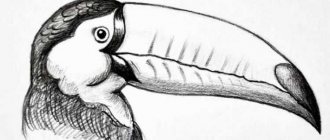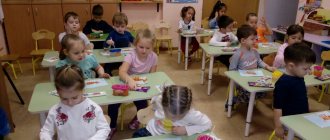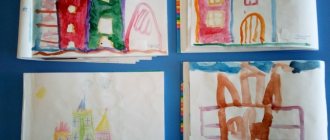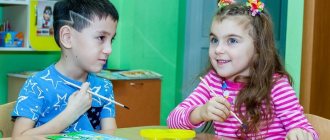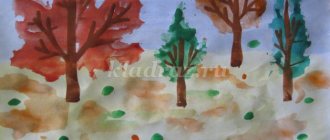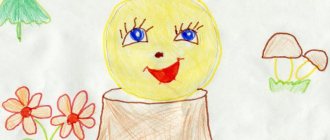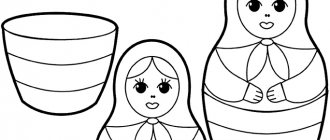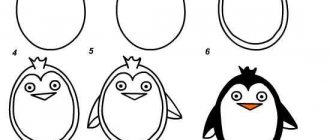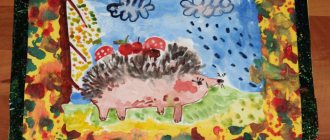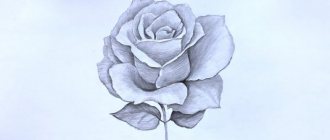Wise Owl
This peculiar representative of the fauna is a frequent hero of children's paintings.
- Her head is represented by a flattened ball, and her pointed body is connected to it by a smooth transition with the absence of a cervical bridge.
- The legs begin with small oval panties and end with claws.
- We finish drawing the pointed ears, a crochet nose and a wing.
- We highlight the feathers on the tail. The eyes are round and yellow.
- The head area is decorated with down strokes. The breast is lighter in color.
Preview:
GOAL: to teach children to sketch birds in motion, conveying the basic shape and main parts.
Practice sketching with one pencil or one paint. Consolidate and expand knowledge about wintering and migratory birds. Cultivate a caring attitude towards birds.
MATERIALS: Landscape sheets tinted with blue-violet color (autumn sky, simple pencils, wax crayons; illustrations depicting birds flying south; reproduction of Stepanov’s painting “The Cranes Are Flying.”
I. Finger gymnastics
Visiting the thumb Put the thumbs of both hands up
Came straight to the house: Index and middle,
Nameless and last. Alternately, the called fingers are connected to the thumbs on both hands at the same time
The little finger itself Fingers are clenched into a fist, only the little fingers point upward
He knocked on the threshold. Fists knock on each other
Together fingers are friends,
They cannot live without each other. Rhythmic clenching of fingers into fists
II. Introductory conversation
- Guys, let's remember what time of year it is (Autumn). Right. And what changes occur in nature with the arrival of autumn (Children list the signs of autumn?)
- Well done! Right! But today I would like to talk about birds. Let's remember what birds we have seen and know (Children's answers). Do they all stay with us for the winter (No? What are the names of those birds that are not afraid of the cold and stay here (Winterers? What wintering birds do you know (Sparrow, crow, tit, bullfinch, dove, owl, woodpecker, magpie?
What are the names of birds that fly away to warmer regions (Migratory? Yes. That’s right. What migratory birds do you know (ducks, swans, cranes, swallows, rooks, starlings, cuckoos? Why do you think they fly away (It’s cold for them here) and have nothing to eat?)
- Right. Flying birds have nothing to eat in winter. Many migratory birds eat insects. However, with the onset of cold weather, all insects hide, so birds fly to warmer regions in search of food.
– Look carefully at the illustrations.
Pay attention to how the birds fly. Waders, herons, and ducks fly in a line, in front or in a transverse row. Geese most often fly in a school. Geese, cranes, swans and other large birds fly in an angle, or wedge.
- Guys, let's rest a little. Imagine that you are birds and repeat after me:
Birds jump and fly. They wave their arms and jump up and down
Birds collect crumbs. "Peck"
The beaks were cleaned. Stroke your hands and noses
Birds fly, sing, wave their arms
The grains are pecked. "Peck"
V. Independent activities of children
– Have you rested? Fine! And now I suggest you draw birds flying south. Look what's on your tables (Children's answers? First we will make a sketch with a simple pencil, and then we will outline and color it with wax pencils.
During the practical part, explain to the children that sketches should be drawn with light lines; they need not be finished, not finished to the end; you can leave the failed form and start another;
I need to try to make more sketches. The resulting sketches are outlined with a wax pencil.
During the lesson, the teacher analyzes the images created by the children, explains mistakes, and guides them in searching for the correct representation of form and movement.
VI. Lesson summary
Educator: Guys, our lesson has come to an end. You have learned a lot about the life of birds. Unfortunately, for a very long time man lived with the confidence that he could take everything from nature without giving anything in return. And now, as a result of thoughtless human activity, our planet is dying. Many plants, animals and birds are completely disappearing or are on the verge of survival. That is why people who cannot look at the death of living nature with indifference have created several volumes of the Red Book, where these plants and animals were listed. They can still be saved.
Educator: Don’t forget that birds are our friends, younger brothers, and we, as elders, must take care of and protect them.
At the end of the work, the children attach the drawings to the board. Demonstration of their works by children; choose the most neat and beautiful works with the children.
– Children, what did we do today (Children’s answers? You did well, you all tried your best and you did a good job. Thank you. This concludes our lesson.)
Eagle
- The proud master of heaven is extremely attractive.
- Having sketched out the bird's body, draw an open beak and a circle-eye on the head.
- Let's detail the picture.
- We frame the open wings with zigzag feathers.
- The tail section is lowered down.
A formidable predator sits on a rock or stump, clinging to it with powerful claws. On his paws are characteristic downy pants. It's not the most affordable offer, but it's worth a try.
Parrot
The colorful Macaw is in demand, so let’s boldly get to work and try to draw this bird step by step:
- We depict a large and small oval; they are smoothly united by a back line ending in a flowing tail.
- The volumetric fragment becomes the basis of the wing, wavy at the bottom.
- Add a convex nose-hook and an eye.
- Marked semicircles will help show how the colors on the head change.
When coloring, use a red and yellow pencil, additionally using a dark blue tone on the tail section and the edges of the wings. Violet and black colors provide relief to the feathers.
And the youngest creators will love the image of a tiny chicken. They will undoubtedly cope with this task.
- The body consists of two circles, painted yellow.
- We draw on the thin paws and beak; the orange fluff along the contours will give the baby some authenticity.
The proposed sketch options provide an answer to the question of how to beautifully draw different birds that are similar to the prototype.
Fine arts lessons not only develop artistic thinking in children, but also enrich them with knowledge about the environment, which is important.
On the topic: methodological developments, presentations and notes
Continue to introduce children to wintering birds and their life in winter; develop creative imagination, attention, ingenuity; generalization and clarification of children’s knowledge about wintering birds; extension.
During the lesson, children get acquainted with the main representatives of wintering birds of the Astrakhan region.
I offer a summary of a lesson for children in the middle group when getting to know birds, in particular the woodpecker.
Summary of a lesson on environmental education for children of senior preschool age.
Summary of direct educational activities for the implementation of the educational area “Cognition” (the child and the world around him) in a preparatory group for school for children with general disabilities.
Summary of direct educational activities for the implementation of the educational area “Cognition” (the child and the world around him) in the middle group for children with general underdevelopment.
Source
flying dove
How to draw a bird easily step by step with a pencil in flight?
A similar task is within the capabilities of young artists:
- We draw the outline of the head, which goes into the bottom of the body.
- The head line is continued by a raised wing, on the edges of which there are zigzags imitating a feather.
- We repeat the silhouette of the second element, located slightly behind.
- Add a ponytail and an eye dot.
- You can put a twig in the dove's mouth, making it a symbol of peace.
The soaring seagull looks interesting, which is characterized by long curved wings, a massive beak and webbed feet.
- Her figure will be made of a circle and an oval, from which elongated triangular wings extend.
- Fan-shaped tail below.
- They have plumage with black edges and a yellow nose.
Swan
The majestic specimen captivates with its grace.
Look how easy it is to draw this handsome guy:
- We outline a circle-head and an oval body; these parts are connected by an elongated swan neck, which is thickened.
- We emphasize with strokes the outlines of the wing and small tail.
- The eye is blue, and the wide beak is reddish with the obligatory nostrils.
- Using chiaroscuro we add volume to the figure.
- We accentuate the blue of the water.
You can display a pair of birds located opposite.
Another long-necked figure is the stork. It is characterized by long, ankle-shaped legs with a middle thickening of orange color and large paws.
Magnificent peacock
The colorful specimen does not hold back your imagination when decorating it, and it is not at all difficult to reproduce it on paper.
Step-by-step instructions for children:
- A peacock's head is a circle with a beak.
- Add a torso configuration with a neck.
- The rest of the space on the album sheet is given to a chic, flowing tail, onto which patterns similar to the leaves of a tree are applied.
- The tail background will be green. We paint the body, eyes and fragments of decoration with bright colors. Don't forget about the characteristic crest.
You can choose colors at your discretion, experimenting and achieving expressiveness.
Bullfinch
- The circle and oval are combined with rulers, the back of which will go into the wing.
- Draw the head elements and the triangular tail.
- We select the feathers and plant the bird on a branch.
We outline the outline in relief and color the winter singer, making the abdomen red, which is its distinctive feature.
